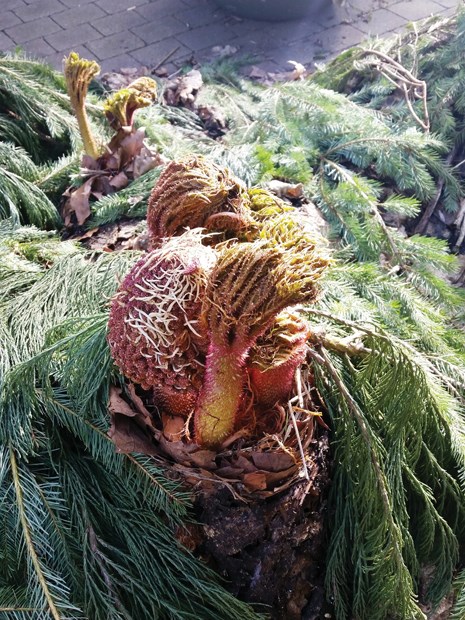This year's early spring is turning out to be a blessing and a bit of curse.
Forsythia, magnolia and camellia have been blooming and many perennials are already starting to grow. Spring is three to four weeks early depending on your geographical location and who you talk to.
In my garden my Gunnera manicata, or giant rhubarb, has been poking through its wintery mulch since Feb. 12 - that's a month earlier than normal. It's a blessing that my Gunnera, or "Gunny" as we call her, is growing earlier in the year. It means I will be able to grow two or three flushes of leaf growth instead of the normal one or small two. And, I will be able to grow leaves eight or nine feet in diameter that reach up five metres or more into the air.
This spring's curse for me has been covering Gunny every night to protect her new leaves and flowers from frost damage. And each morning before I go to work, I go out and remove the blankets on her ever-expanding leaves. It's a prehistoric and captivating experience in the mist of morning.
With early spring comes early opportunity. Here's what to do in the garden to take advantage of an early spring.
Cover those beds Use mulch to protect and enhance all planting beds and stand alone trees. Mulch provides nutrients that are released through long-term microbial digestion. Worms, bacteria, fungi, sow bugs and other organisms eat the mulch and turn it into food for plants - kind of like a living carbon digester that produces fertilizer.
A good mulch cover also prevents drought and freezing stress on plants and soil organisms.
One of the main benefits of mulch is weed suppression. Applied at least three to four inches thick, mulch will prevent all weed growth except existing perennial weeds that must be hand dug.
And lastly, mulch is the canvas upon which the garden's painting is created. Mulch unifies the background providing visual emphasis on plants and composition.
Spare the weed killer Spring is early and so are weeds. If you weed now to prevent future weed flowering and seeding, you will drastically reduce the number of weeds in the garden this year.
If you must weed in the garden, use a tool, don't be a tool. There are many good weed hoes and cultivators that allow a person to stand upright to weed. Buy a strong, lightweight, wood-handled weeder with a long handle. Weeding on your hands and knees is simply not the Jedi way.
For people who are still addicted to spraying poisonous herbicides to control weeds, try these alternatives. Use a handheld weed burner. There are B.C. companies selling good models that work.
Try hot water mixed with baking soda, salt or vinegar or a combination thereof. Practise mixing a good strength that kills the weeds but is not strong enough to cause environmental damage.
Salt will affect surrounding plants if applied in large doses. Baking soda will affect living creatures and plants if applied in large doses. Vinegar is less damaging than the other ingredients but it can smell a bit funky.
Install polymeric sand between the joints of paving stones, flag stones or large natural stone slabs. Polymeric sand is applied by sweeping it in and then lightly misting it to provide enough moisture to allow the polymeric to harden like mortar. This will help prevent weeds from growing in the joints between stones.
Address the darn chafers in the lawn Not all lawn damage caused by crows, raccoons, skunks and squirrels is a result of chafer damage. Those animals have been habituated to lawns over the past 60 years as a food source for worms and other insects. So before you freak out and start spraying nematodes or worse, some poisonous pesticide, do some investigation by digging and looking for the sizeable pale to whitish chafer grubs.
Replanting grass is the typical option. But during my recent visit to the B.C. Home and Garden Show at B.C. Place, I noticed most landscaping booths were showing artificial turf designed for residential use. A sign of the times? For lawn replacement, consider alternatives like walkways, patios, beds, veggies, groundcovers, xeriscaping or whatever else suits your lifestyle.
For lawn maintenance, restrict fertilizer to later in the season and smaller amounts. There is no need to lime lawns every year despite seductive marketing to the contrary. Lawns can be limed every three, four or five years depending on pH test results.
And lastly, in the immortal words of Leonard Nimoy, "A life is like a garden. Perfect moments can be had, but not preserved, except in memory."
So get outside and enjoy the spring.
Todd Major is a journeyman horticulturist, garden designer and builder, teacher and organic advocate. [email protected]



